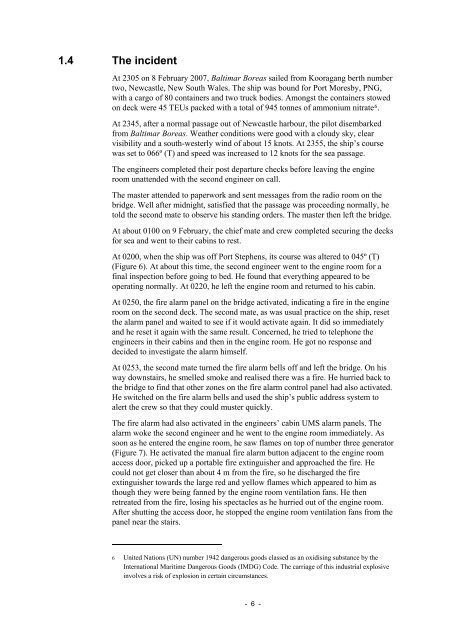Marine Report 236, Independent investigation into the engine room ...
Marine Report 236, Independent investigation into the engine room ...
Marine Report 236, Independent investigation into the engine room ...
Create successful ePaper yourself
Turn your PDF publications into a flip-book with our unique Google optimized e-Paper software.
1.4 The incident<br />
At 2305 on 8 February 2007, Baltimar Boreas sailed from Kooragang berth number<br />
two, Newcastle, New South Wales. The ship was bound for Port Moresby, PNG,<br />
with a cargo of 80 containers and two truck bodies. Amongst <strong>the</strong> containers stowed<br />
on deck were 45 TEUs packed with a total of 945 tonnes of ammonium nitrate 6 .<br />
At 2345, after a normal passage out of Newcastle harbour, <strong>the</strong> pilot disembarked<br />
from Baltimar Boreas. Wea<strong>the</strong>r conditions were good with a cloudy sky, clear<br />
visibility and a south-westerly wind of about 15 knots. At 2355, <strong>the</strong> ship’s course<br />
was set to 066º (T) and speed was increased to 12 knots for <strong>the</strong> sea passage.<br />
The <strong>engine</strong>ers completed <strong>the</strong>ir post departure checks before leaving <strong>the</strong> <strong>engine</strong><br />
<strong>room</strong> unattended with <strong>the</strong> second <strong>engine</strong>er on call.<br />
The master attended to paperwork and sent messages from <strong>the</strong> radio <strong>room</strong> on <strong>the</strong><br />
bridge. Well after midnight, satisfied that <strong>the</strong> passage was proceeding normally, he<br />
told <strong>the</strong> second mate to observe his standing orders. The master <strong>the</strong>n left <strong>the</strong> bridge.<br />
At about 0100 on 9 February, <strong>the</strong> chief mate and crew completed securing <strong>the</strong> decks<br />
for sea and went to <strong>the</strong>ir cabins to rest.<br />
At 0200, when <strong>the</strong> ship was off Port Stephens, its course was altered to 045º (T)<br />
(Figure 6). At about this time, <strong>the</strong> second <strong>engine</strong>er went to <strong>the</strong> <strong>engine</strong> <strong>room</strong> for a<br />
final inspection before going to bed. He found that everything appeared to be<br />
operating normally. At 0220, he left <strong>the</strong> <strong>engine</strong> <strong>room</strong> and returned to his cabin.<br />
At 0250, <strong>the</strong> fire alarm panel on <strong>the</strong> bridge activated, indicating a fire in <strong>the</strong> <strong>engine</strong><br />
<strong>room</strong> on <strong>the</strong> second deck. The second mate, as was usual practice on <strong>the</strong> ship, reset<br />
<strong>the</strong> alarm panel and waited to see if it would activate again. It did so immediately<br />
and he reset it again with <strong>the</strong> same result. Concerned, he tried to telephone <strong>the</strong><br />
<strong>engine</strong>ers in <strong>the</strong>ir cabins and <strong>the</strong>n in <strong>the</strong> <strong>engine</strong> <strong>room</strong>. He got no response and<br />
decided to investigate <strong>the</strong> alarm himself.<br />
At 0253, <strong>the</strong> second mate turned <strong>the</strong> fire alarm bells off and left <strong>the</strong> bridge. On his<br />
way downstairs, he smelled smoke and realised <strong>the</strong>re was a fire. He hurried back to<br />
<strong>the</strong> bridge to find that o<strong>the</strong>r zones on <strong>the</strong> fire alarm control panel had also activated.<br />
He switched on <strong>the</strong> fire alarm bells and used <strong>the</strong> ship’s public address system to<br />
alert <strong>the</strong> crew so that <strong>the</strong>y could muster quickly.<br />
The fire alarm had also activated in <strong>the</strong> <strong>engine</strong>ers’ cabin UMS alarm panels. The<br />
alarm woke <strong>the</strong> second <strong>engine</strong>er and he went to <strong>the</strong> <strong>engine</strong> <strong>room</strong> immediately. As<br />
soon as he entered <strong>the</strong> <strong>engine</strong> <strong>room</strong>, he saw flames on top of number three generator<br />
(Figure 7). He activated <strong>the</strong> manual fire alarm button adjacent to <strong>the</strong> <strong>engine</strong> <strong>room</strong><br />
access door, picked up a portable fire extinguisher and approached <strong>the</strong> fire. He<br />
could not get closer than about 4 m from <strong>the</strong> fire, so he discharged <strong>the</strong> fire<br />
extinguisher towards <strong>the</strong> large red and yellow flames which appeared to him as<br />
though <strong>the</strong>y were being fanned by <strong>the</strong> <strong>engine</strong> <strong>room</strong> ventilation fans. He <strong>the</strong>n<br />
retreated from <strong>the</strong> fire, losing his spectacles as he hurried out of <strong>the</strong> <strong>engine</strong> <strong>room</strong>.<br />
After shutting <strong>the</strong> access door, he stopped <strong>the</strong> <strong>engine</strong> <strong>room</strong> ventilation fans from <strong>the</strong><br />
panel near <strong>the</strong> stairs.<br />
6 United Nations (UN) number 1942 dangerous goods classed as an oxidising substance by <strong>the</strong><br />
International Maritime Dangerous Goods (IMDG) Code. The carriage of this industrial explosive<br />
involves a risk of explosion in certain circumstances.<br />
- 6 -
















